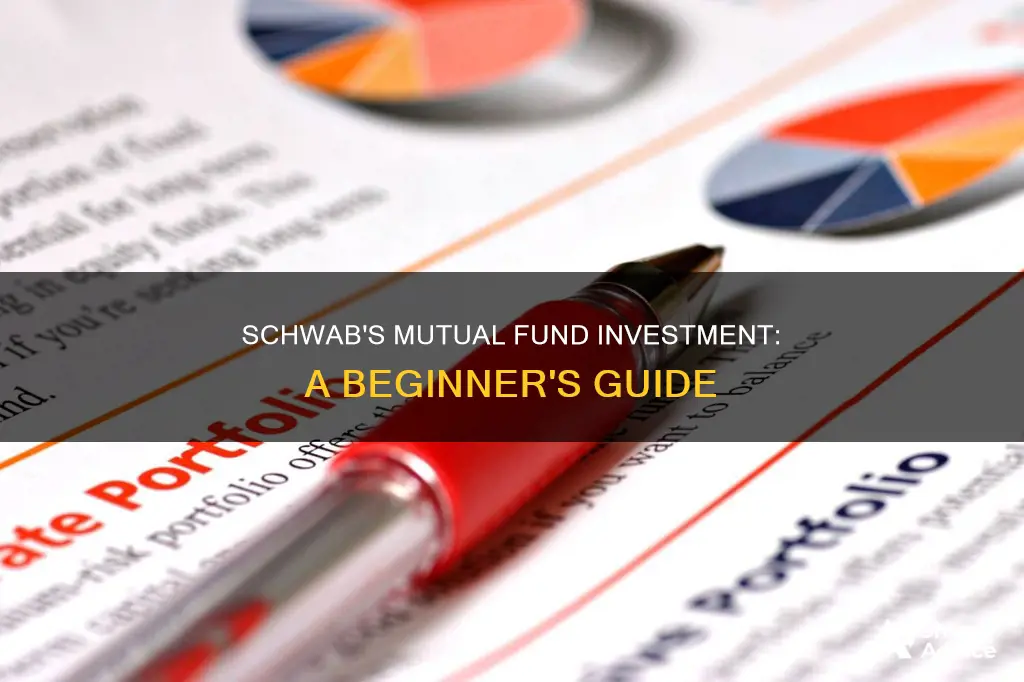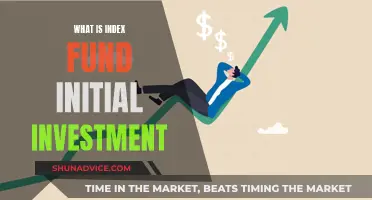
Investing in mutual funds with Charles Schwab is a great way to access a wide variety of funds across all asset classes, including commodities, European equities, and high-yield bonds, many with no transaction fees. Schwab's funds are managed by Schwab Asset Management, a market leader in index mutual funds, which are designed to track a specific index such as the S&P 500. With Schwab, you can choose from a range of funds aligned with your investment goals, whether you're focused on growth, stability, or something else. In this paragraph, we will explore the steps to investing in mutual funds with Charles Schwab, as well as the costs and benefits of doing so.
| Characteristics | Values |
|---|---|
| Number of mutual funds | 3,000+ no-load, no-transaction-fee mutual funds |
| Types of mutual funds | Actively managed, passively managed, index mutual funds, and more |
| Top-performing mutual funds | Schwab S&P 500 Index Fund (SWPPX), Schwab 1000 Index Fund (SNXFX), Schwab International Index Fund (SWISX), Schwab U.S. Large-Cap Growth Index Fund (SWLGX), Schwab Health Care Fund (SWHFX), Schwab Balanced Fund (SWOBX), Schwab Target 2065 Index Fund (SWYOX) |
| Investment process | Log in to your account, select "Trade" and "Mutual Funds", enter the symbol, select "Buy" from the "Action" dropdown, enter the amount to invest, select the reinvestment option, and review and place the order |
| Costs and fees | Operating expenses, loads, transaction fees, trade commissions, portfolio management fees |
| Tools | Fund Finder tool, Mutual Fund OneSource Select List®, ETF Select List® |
What You'll Learn

Choose from a wide variety of mutual funds across all asset classes
Charles Schwab offers a wide range of mutual funds across all asset classes, allowing investors to choose funds that align with their specific investment goals and preferences. These include commodities, European equities, and high-yield bonds, among others. Many of these funds come with no transaction fees, making them an attractive option for cost-conscious investors.
When it comes to mutual funds, investors can choose from two main types: index mutual funds and actively managed mutual funds. Index mutual funds, also known as passive funds, are designed to track a specific index rather than outperform it. For example, the Schwab S&P 500 Index Fund (SWPPX) aims to replicate the performance of the S&P 500 index. These funds are typically low-cost and have lower operating expense ratios compared to actively managed funds.
Actively managed mutual funds, on the other hand, are overseen by portfolio managers who actively select securities they believe will outperform the market. An example of this is the Schwab Health Care Fund (SWHFX), which focuses on pharmaceuticals, biotechnology, and medical services companies. While these funds may have higher expenses due to the active management, they offer the potential for higher returns if the fund managers' strategies are successful.
To help investors navigate the wide array of choices, Schwab provides a Mutual Fund OneSource Select List®, a pre-screened list of no-load, no-transaction-fee mutual funds that are evaluated based on performance, risk, income, and expense. This list can be a valuable tool for investors looking to narrow down their options and identify funds that align with their investment criteria.
Additionally, investors can utilise the Fund Finder tool to screen for mutual funds that meet their specific criteria, such as asset class, investment strategy, or risk tolerance. This tool empowers investors to take a proactive approach to finding funds that match their unique needs and preferences.
With its extensive selection of mutual funds across all asset classes, Charles Schwab provides investors with the flexibility and choice needed to build a diversified portfolio tailored to their investment goals. By offering a combination of index and actively managed funds, along with resources like the Mutual Fund OneSource Select List® and the Fund Finder tool, Schwab enables investors to make informed decisions as they navigate the world of mutual fund investing.
Understanding 401(k) Investment: Timing Your Retirement Savings
You may want to see also

Understand the costs and fees involved
When investing in mutual funds, it's important to understand the costs and fees involved. These fees can impact your overall returns, so it's essential to factor them into your decision-making process. Here's a detailed breakdown of the costs and fees you may encounter when investing in mutual funds through Charles Schwab:
Operating Expenses:
The Operating Expense Ratio (OER) is an annual fee charged by the fund company, typically expressed as a percentage of the fund's average net assets. This fee covers the fund's management and other operational costs. Passively managed funds, which track a specific market index, generally have lower OERs than actively managed funds, where fund managers actively make investment decisions. At Schwab, the OER for passively managed funds can range from 0.02% to 0.39%, while actively managed funds have OERs ranging from 0.21% to 1.09%.
Loads:
Loads are a type of commission or sales charge that some mutual funds impose when you purchase or redeem shares. These fees are typically used to compensate the broker involved in the transaction. At Schwab, you can choose from a wide range of no-load funds, which means there are no sales charges or commissions associated with buying or selling shares.
Transaction Fees:
When you buy or redeem mutual fund shares, your brokerage company may charge a trade fee or transaction fee. This fee may be used to compensate the brokerage firm for facilitating the transaction. At Schwab, you can choose from over 3,000 no-transaction-fee mutual funds, which means you can buy or sell shares without incurring additional transaction costs.
Management Fees:
If you opt for a professionally managed portfolio or investment advisory services, there will be additional management fees involved. These fees are typically based on a percentage of your assets under management and can vary depending on the level of assets and the services provided. It's important to consider these fees in conjunction with any underlying investment costs, such as mutual fund OERs.
Fund-Specific Fees:
Different mutual funds may have their own unique fee structures or additional costs. For example, some funds may have minimum investment requirements or redemption fees if you sell your shares within a specified period. It's important to carefully review the prospectus or offering documents of the specific mutual fund you're considering to understand all the associated costs and fees.
Remember, understanding the costs and fees associated with mutual fund investing is crucial for making informed investment decisions. While some expenses are inherent in the nature of mutual funds, being aware of these fees can help you compare different investment options and choose the ones that align best with your financial goals and tolerance for fees and expenses.
Best Banks for Investment: Where to Invest Your Money?
You may want to see also

Select a fund that aligns with your investment goals
When selecting a mutual fund that aligns with your investment goals, it's important to consider your risk tolerance and overall financial objectives. Here are some factors to keep in mind:
Investment Goals and Risk Tolerance
Your investment goals and risk tolerance play a crucial role in choosing the right mutual fund. For instance, if you are a growth-focused investor, you might prefer equity funds with strong historical performance. On the other hand, if stable income is your priority, you may want to opt for funds with a strong track record of providing consistent returns. It's essential to strike a balance between the potential returns and the level of risk you are comfortable with.
Morningstar Ratings
Morningstar, a reputable investment research firm, provides a rating system that evaluates funds based on their historical performance, taking into account both returns and volatility. These ratings, ranging from one to five stars, are recalculated monthly and are based on risk-adjusted performance. Funds with four or five stars have consistently offered more returns per unit of risk and are considered the best performers within their specific categories.
Types of Mutual Funds
Schwab offers a wide range of mutual funds to suit different investment goals. You can choose from index mutual funds, which aim to track a specific market index like the S&P 500, or actively managed mutual funds, where portfolio managers actively select securities to outperform benchmarks. Actively managed funds tend to be more expensive due to the involvement of fund managers. Additionally, you can explore options like large-cap, small-cap, or blend funds, depending on your desired level of diversification.
Expense Ratios
Expense ratios represent the annual fees charged by the fund company, expressed as a percentage of the fund's average net assets. When comparing mutual funds, it's essential to consider their expense ratios. Passive funds, such as index funds, generally have lower expense ratios than actively managed funds. Lower expense ratios can translate to more cost-effective investments, especially when investing large sums of money.
Fund Performance and Turnover Rate
Examining the historical performance of a mutual fund can provide insights into its potential for generating returns. Additionally, considering the portfolio turnover rate is crucial. A low portfolio turnover rate indicates good tax efficiency, as frequent buying and selling of securities within the fund can trigger taxable events.
Utilize Schwab's Resources
Schwab offers a variety of tools and resources to help you make informed decisions. The Mutual Fund OneSource Select List® can assist in narrowing down your search by providing a pre-screened list of mutual funds based on performance, risk, income, and expense criteria. Additionally, you can utilize the Fund Finder tool to explore funds that align with your specific criteria and investment goals.
Remember, investing in mutual funds involves risks, and past performance does not guarantee future results. It's always recommended to carefully consider your own financial situation and consult with a qualified financial advisor before making any investment decisions.
Best SBI Mutual Fund Schemes for Investors
You may want to see also

Use the All-In-One Trade Ticket to invest
To invest in a mutual fund, you can use the All-In-One Trade Ticket on the Schwab website. Here's a step-by-step guide on how to do it:
Step 1: Access the All-In-One Trade Ticket
- Log in to your Schwab account and navigate to the Trade tab.
- From the Trade tab, select the "All-In-One Trade Ticket" option. This will open up the All-In-One Trade Ticket page, where you can start building your trade order.
Step 2: Select your Account
From the dropdown menu, choose the specific account you'd like to use for this investment.
Step 3: Enter the Mutual Fund Information
In the "Symbol" field, type in the symbol or name of the mutual fund you're interested in. This will pull up the current price details for that fund.
Step 4: Choose "Buy" and Enter Investment Amount
- From the "Action" dropdown menu, select "Buy."
- In the "Amount in Dollars" field, enter the amount of money you'd like to invest in the mutual fund.
Step 5: Choose Reinvestment Option
Decide on your preferred reinvestment option. You can choose from the three options provided: dividends, capital gains, or no reinvestment.
Step 6: Select Transaction Fee Option
If the mutual fund has transaction fees, choose the transaction fee option that suits you. You can either add the fee to the total or deduct it from the total.
Step 7: Review and Place Order
- Once you've entered all the necessary information, click on "Review Order" to check the details of your trade.
- If everything looks correct, click on "Place Order" to submit your trade request.
The All-In-One Trade Ticket allows you to trade various asset types, including stocks, ETFs, options, futures, and futures options, all from a single page. It's designed to be fast and intuitive, providing you with the relevant information needed to make your trades efficiently.
By following these steps, you can easily invest in a mutual fund of your choice using the All-In-One Trade Ticket on the Charles Schwab platform.
Funding an Investment Farm: Strategies for Success
You may want to see also

Research and compare funds using Morningstar ratings
Morningstar is a research and investment management firm that provides a wide range of financial products and services to both individual and professional investors. They offer comprehensive data, analytics, and insights on various investment options, including mutual funds. Morningstar's ratings are a valuable tool for investors when researching and comparing mutual funds. Here's how you can use Morningstar ratings to make informed decisions about mutual funds offered by Charles Schwab:
Understanding Morningstar Ratings:
Morningstar's ratings, also known as the "star rating" or the Morningstar Rating for funds, is a widely recognized evaluation system that helps investors assess the performance of mutual funds. The ratings are calculated based on a fund's risk-adjusted return, considering both upward and downward variations in performance. The system compares funds within the same category, making it easier to identify the best-performing funds relative to their peers.
Morningstar Rating Calculation:
Morningstar calculates the ratings by evaluating the performance of a mutual fund over three-, five-, and ten-year periods, if applicable. The weight assigned to each period varies depending on the total length of available performance data. For funds with 36 to 59 months of total returns, the three-year rating is given a weight of 100%. As the length of available data increases, the weight distribution changes. For funds with 60 to 119 months of total returns, the five-year rating receives 60% weight, while the three-year rating gets 40%. For funds with 120 or more months of total returns, the weights are adjusted to 50% for the ten-year rating, 30% for the five-year rating, and 20% for the three-year rating.
Rating Scale and Interpretation:
Morningstar's star ratings range from one to five stars, with the top 10% of funds in each category receiving five stars, the next 22.5% receiving four stars, the middle 35% receiving three stars, the next 22.5% receiving two stars, and the bottom 10% receiving one star. These ratings indicate how well a fund has performed relative to other funds in its category, with higher ratings suggesting stronger risk-adjusted performance.
Applying Morningstar Ratings to Schwab Mutual Funds:
When researching and comparing Schwab mutual funds, you can utilize Morningstar ratings as a tool to assess their performance. For example, according to Morningstar ratings as of August 31, 2024, several Schwab Funds® have received four and five stars, indicating superior risk-adjusted returns. These highly rated funds include the Schwab® S&P 500 Index Fund, Schwab Fundamental U.S. Large Company Index Fund, Schwab Target 2065 Index Fund, and more.
By incorporating Morningstar ratings into your investment decision-making process, you can identify mutual funds that have demonstrated strong performance relative to their peers. However, it's important to remember that past performance is not a guarantee of future results, and other factors should also be considered when making investment choices.
Proprietary Funds: Risky Business for Investors
You may want to see also
Frequently asked questions
You can start by logging into your Schwab account and using the Fund Finder tool to explore mutual funds. You can also refer to the "How to Buy Funds on Schwab.com" video tutorial on their website.
Some of the top-performing mutual funds offered by Charles Schwab include the Schwab S&P 500 Index Fund (SWPPX), Schwab 1000 Index Fund (SNXFX), and Schwab International Index Fund (SWISX). These funds have received four or five-star Morningstar ratings based on their risk-adjusted performance.
The choice of a mutual fund depends on your individual investment goals and risk tolerance. You can use the Morningstar rating system, which evaluates funds based on their historical performance, to help you make an informed decision.
When investing in mutual funds, you should consider operating expenses, loads, and transaction fees. Operating Expense Ratios (OERs) are charged annually and cover the fund's management and other costs. Actively managed funds tend to have higher OERs compared to passively managed funds. Additionally, some funds may charge a one-time commission called a load, and your brokerage company may charge a trade fee when you buy or sell a mutual fund.
Once you've identified the mutual fund you want to invest in, go to the Trade section and choose "All-In-One Trade Ticket." Select the account you want to use from the dropdown menu, then enter the symbol or name of the mutual fund. Choose "Buy" from the "Action" dropdown, enter the amount you want to invest, and select your preferred reinvestment option. Review your order details and then place the order.







